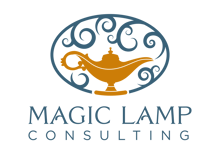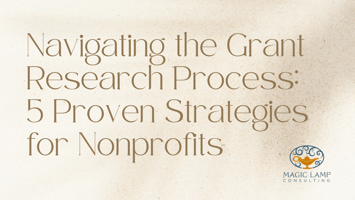Securing grants is a cornerstone of nonprofit sustainability and growth. However, the journey from...
Getting Started with Grants: A Beginner's Guide for Nonprofits

Grant funding can be a game-changer for nonprofits looking to expand their impact and sustain their mission. Grants are another way to diversify a nonprofit’s revenue stream and provide essential funding enabling organizations to carry out their programs, initiatives, and community projects. However, the process of pursuing grants can seem daunting, especially for smaller nonprofits or those new to grant-seeking. With you in mind, the Magic Lamp Consulting team has put their grant writing expertise to the challenge and created a step-by-step guide on how nonprofits can begin the process of receiving grants.
Step 1: Define Your Organization’s Goals and Determine Budget Requirements
Before diving into the world of grant seeking, it's important to have a clear understanding of your organization's goals and budget requirements. This includes identifying:
- What specific projects or programs require funding?
- How much funding is needed to execute these initiatives effectively?
- How will grant funding support short-term and long-term goals?
This information will help you identify grant opportunities that align with your mission and objectives.
Step 2: Research Grant Opportunities
Once you have a good understanding of your needs and goals, you can start researching grant opportunities. Grants come from a variety of sources, including government agencies, private foundations, and corporations. To find the right grants dedicate time to comprehensive grant research. Use online databases, grant directories, and nonprofit networks to identify potential funders that align with your mission. Consider the eligibility criteria, deadlines, and funding priorities for each opportunity.
Step 3: Develop a Solid Grant Proposal
Once you have found a few grants you are interested in, it’s time to begin crafting a compelling grant proposal. The proposal should be tailored to each grantmaker you are applying for by clearly, concisely, and persuasively addressing the funder's priorities and goals. Typical grant applications include an Executive Summary, Needs Statement, Project Description, Budget, Goals/Objectives, and a Timeline/Methodology.
Step 4: Cultivate Relationships with Potential Funders
Establishing and maintaining relationships with potential funders helps increase the likelihood of receiving grant funding.. Networking at industry events, workshops, and conferences can help you engage with funders and peers. Developing strong connections can open doors to valuable grant opportunities and collaborations.
Step 5: Apply Strategically
Be strategic in your grant applications, ensure that the opportunity aligns with your mission and programs. Creating programs just to apply for a grant is highly discouraged. Once you've identified suitable grants and crafted compelling proposals, it's time to apply. Be mindful of deadlines, submission requirements, and any additional documentation needed. Don’t wait until the last minute to start crafting your proposal. Giving yourself plenty of time helps ensure you’ll have a strong proposal that is well-written. Grants management includes keeping meticulous records of your submission dates and status.
Step 6: Follow Up and Stay Engaged
Even after submitting your grant proposals, it is important to follow up and stay engaged with grantmakers. If a funder requests additional information or clarification, e responsive and provide any requested materials promptly. If awarded grant funding, write a thank you note. In addition, invite the funder to visit the nonprofit, and keep the funder informed of your progress and any changes to the project or program. Having a strong relationship with funders can increase your chances of receiving grants in the future.
Step 7: Grant Management and Reporting
Once you secure a grant, the work doesn't end with the funds' arrival. Proper grant management and reporting are critical. Project implementation as proposed in the application, track expenses, and adhere to any reporting requirements specified by the grantmaker. Demonstrate accountability and transparency by communicating progress and impact to the funder.
Grant awards can be a transformative experience for nonprofits, allowing them to expand their reach and make a more significant impact. While the process may seem daunting at first, with careful planning, research, and relationship-building, nonprofits can navigate the grant acquisition process successfully. Stay persistent, stay committed to your mission, and continue seeking opportunities to secure the funding needed to drive positive change in your community.
Looking for more resources on grants? Explore over a dozen other grant-writing blogs we have developed for nonprofit organizations just like you!




